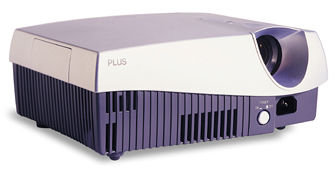PLUS Piano HE-3100 Tabletop DLP Projector
Let's face it. Cheeseburgers, at least to low-income-bracket electronics reviewers, are one of three perfect foods (pizza and beer being the other two). So, I greatly anticipated tasting southwest-U.S.-based fast-food chain Carl's Jr.'s Six-Dollar Burger . . . for $3.95. Supposedly, we can now have the same-quality burger normally found at Chili's or T.G.I. Friday's or wherever, but for less money. It was with much the same anticipation that I looked upon PLUS Corporation's announcement that they would market a $3,000 DLP projector, dubbed the Piano. Since most home-theater-based DLP projectors, like the ones in our recent Face Off (October 2001), cost around $10,000, $3,000 seemed like a pretty tasty deal.

I'm sure that many cynics are already fiercely tapping away at their keyboards, eager to e-mail me about the number of inexpensive business projectors available that are undoubtedly as good as—and less expensive than—their home theater counterparts. PLUS normally makes these kinds of presentation projectors, which corporate salespeople use as portable monitors for their PowerPoint presentations. However, until now, I've found that the vast majority of these projectors lack significant features that are necessary for home theater use.
The Piano HE-3100 utilizes Texas Instruments' latest DMD dual-mode chip. This display uses an 848:600 mirror array to create the image, which (for anyone without a calculator) comes out to a 1.41:1 aspect ratio. Why the weird aspect ratio? A typical SVGA chip (800:600) has to scale widescreen, 480-line NTSC images down to 450 lines (800:450) to fit the chip's 16:9 area. On the HE-3100, the same image uses 848 by 480 pixels, which requires no scaling. Standard 4:3 images can still use the 800:600 array, so computer images don't have to be scaled, either. It's a great compromise.
Speaking of compromises, PLUS made few when they added scaling to this display. Surprising at this price point, the projector uses Silicon Image's excellent Sil 503 deinterlacer. This processor (the same one used in the iScan line doubler) employs excellent 3:2-pulldown detection to convert 480i images into 480p without motion artifacts or jagged edges. This is a feature you rarely see in presentation displays. A progressive-scan DVD player may offer a sharper picture, but it doesn't have any fewer motion artifacts. The projector does introduce minor scaling anomalies in the 16:9 mode; however, for the money, it does an excellent job of handling both film and video images.
The sandwich-sized HE-3100 handles any NTSC home theater source. It's stacked with good fixings like composite, S-video, and component (Y/Pb/Pr) inputs, so it can accept nearly any connection, although you may need an external switcher. The HE-3100 shows its presentation roots with its DVI-D input, which provides a purely digital connection to a computer. Other than the detachable power cord, that's about it. Of course, PLUS could not have fit much else on this tiny unit. After all, you could stack the projector on top of your cable box and still have room for your soda.
Neither the component nor the DVI-D input accepts 1080i or 720p HDTV signals. While this might normally force us to dismiss the display, 480p can look pretty good and is as much as the HE-3100's chip can handle anyway. The best DLP displays to date only output 576p. At the 2001 CEDIA expo, several manufacturers announced plans for true HD-ready DLPs with 720p arrays, but these cost $12,000 or more. For those of you who live in TV markets that don't have a lot of broadcast HD material, the PLUS projector is a viable option.
Being effectively illiterate (i.e., we're too lazy to read an owner's manual), technical consultant Ron Williams, associate editor Geoffrey Morrison, and I stared at the unit for about 10 minutes before we figured out how to turn it on. You have to hold down the power button for a few seconds. Other than that, the remote and projector are easy to set up. The necessary home theater adjustments, such as gray scale and gamma, are included. Gamma adjustment is important, as computers and home theater setups use distinctly different gamma curves. When you watch video images on a computer display, medium-intensity images seem too bright, relative to darker and lighter images. The Piano projector's gamma matches exactly with the needs for video, but it has alternate modes for a computer. Only projectors that cost three times as much, from companies like Sèleco and Runco, offer this feature.
Installation is easy and reasonably flexible. The unit works in front- and rear-firing, floor- and ceiling-mounted positions. In our front-firing, floor-mounted position, the projector sits low to the screen. This would be an advantage in a ceiling-mounted installation, as it gets the projector up and out of the way. Since the projector uses a fixed-throw lens, you have to have some placement flexibility. There's no zoom control, which means you have to move the projector itself forward and backward until the image fills the screen.
- Log in or register to post comments




































































